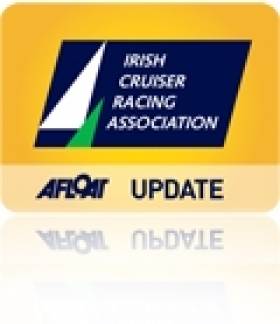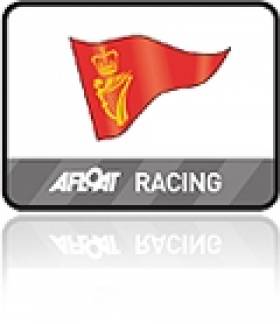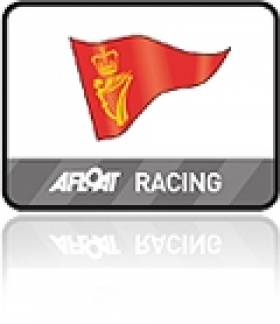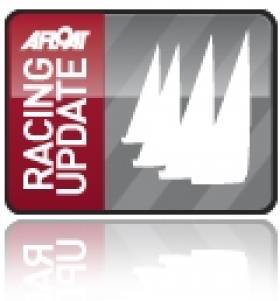Displaying items by tag: Jelly Baby
J109 ‘Jelly Baby’ Heading North for Restoration
Kevin O’Neill’s boat-shed at Kirkistown on the Ards Peninsula in Co Down has seen many boat restorations, the most recent being the MGRS 34, Twenty Twenty for Rex Robinson of Dublin Bay (renamed Debbie R in memory of his late wife) and another MGRS 34, Juno, for Kevin’s and his son Terence’s own use.
Kevin’s latest project has arrived on its long road trip from Cork Harbour to Northern Ireland. It is Jelly Baby, the J109 which faced destruction when it came to grief on Weavers Point during the final race of Royal Cork’s Autumn League last October.
She was refloated from Bull Rock by the coastguard and a salvage team, and laid up in Crosshaven Boatyard.
 Jelly Baby was laid up in Crosshaven Boatyard following the J109’s grounding at the mouth of Cork Harbour
Jelly Baby was laid up in Crosshaven Boatyard following the J109’s grounding at the mouth of Cork Harbour
Subsequently tracked down by Kevin’s son Terence, she is now on her way to Kirkistown. But it would be a dream that she’d be ready for racing in Strangford Lough this season.
Kevin says Jelly Baby will have “a complete overhaul and be back on the race course again, maybe not this season but the 2023 season”.
It is certainly heartening to see boats being restored and racing again.
 Jelly Baby is lifted into position for the road to the Ards Peninsula
Jelly Baby is lifted into position for the road to the Ards Peninsula
#sovscup – No surprises that form boat Jelly Baby leads division one of the 2015 ICRA Nationals in Kinsale Yacht Club tonight writes Claire Bateman. No surprise either that another Irish UK champion this season is also in the frame after two light races on the south coast.
The annual (ICRA) championship that combines the club's Sovereigns' Cup event runs until Saturday. The event featured in today's Afloat enews. For more click here.
Forecasted moderate to fresh south–westerly winds gusting up to 25 mph that look set to provide perfect racing conditions for the 122–boat fleet failed to materialise this afternoon as did the summer sunshine.
Ian Nagle's Royal Cork leader – that has already chalked up two UK victories this season – is a single point ahead of J109 sistership Joker II (John Maybury) in the biggest fleet of the championship. Third, six points off the lead, is May's Scottish series winner Fool's Gold skippered by Rob McConnell of Waterford Harbour, Afloat's sailor of the month for May.
But despite the Munster lead in division in one, it is Howth Yacht Club that has set a strong early pace in the four-day series off the Old Head of Kinsale. The north Dublin club holds leading places in four of the eight racing divisions including the top four boats in Division 2.
Kinsale was like a deserted village when everybody had taken to the water. The day was dull and had what started out as a light breeze that filled in later in the day.
Former RCYC Admiral Peter Deasy reported from Class Three that it was very competitive and a very enjoyable day's racing.
Fleets were divided into red and green to alternate each day between windward/leeward and round the cans courses.
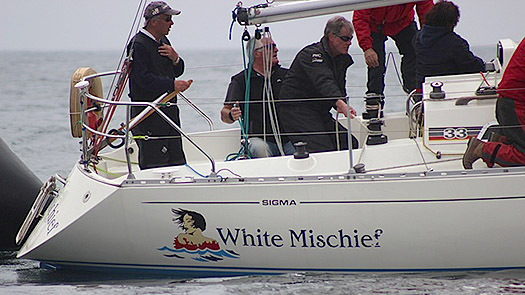
Champion Sigma 33 White Mischief skippered by Timothy Goodbody of the Royal Irish Yacht Club is fourth in class three
Class Three were to sail today on the round the cans course but due to the fickle breeze in the morning Race Officer Jack Roy set a windward/leeward course and shortened it to two rounds instead of three. As the wind filled in during the day a round the cans course was set and while the Desmond/Deasy Ivers Bad Company (RCYC) led all the way from the weather mark, she was caught at the finish by Richard Colwell's Corby 25 who had a two and a one in IRC with Bad Company on three and two in second and another Corby 25 , Paul Tingle's Alpaca (RCYC) also enjoying the lighter conditions lying third.
Meanwhile, in Alan Crosbie's red fleet sailing the windward/leeward course were Classes Zero, One and Two, and in the lighter airs of the morning ICRA Commodore, Norbert Reilly, sailing the Mills 36 Crazy Horse Zero took the first gun followed by regular visitor to Ireland Andy Williams of Yealm Yacht Club in his Ker 40 Keronimo, in second but these positions were reversed in Race Two so an interesting battle is already developing in this fleet. Currently lying third is the Jonathan Anderson Roxstar an XP381 followed by local RCYC boat Denise and Conor Phelan's Jump Juice.
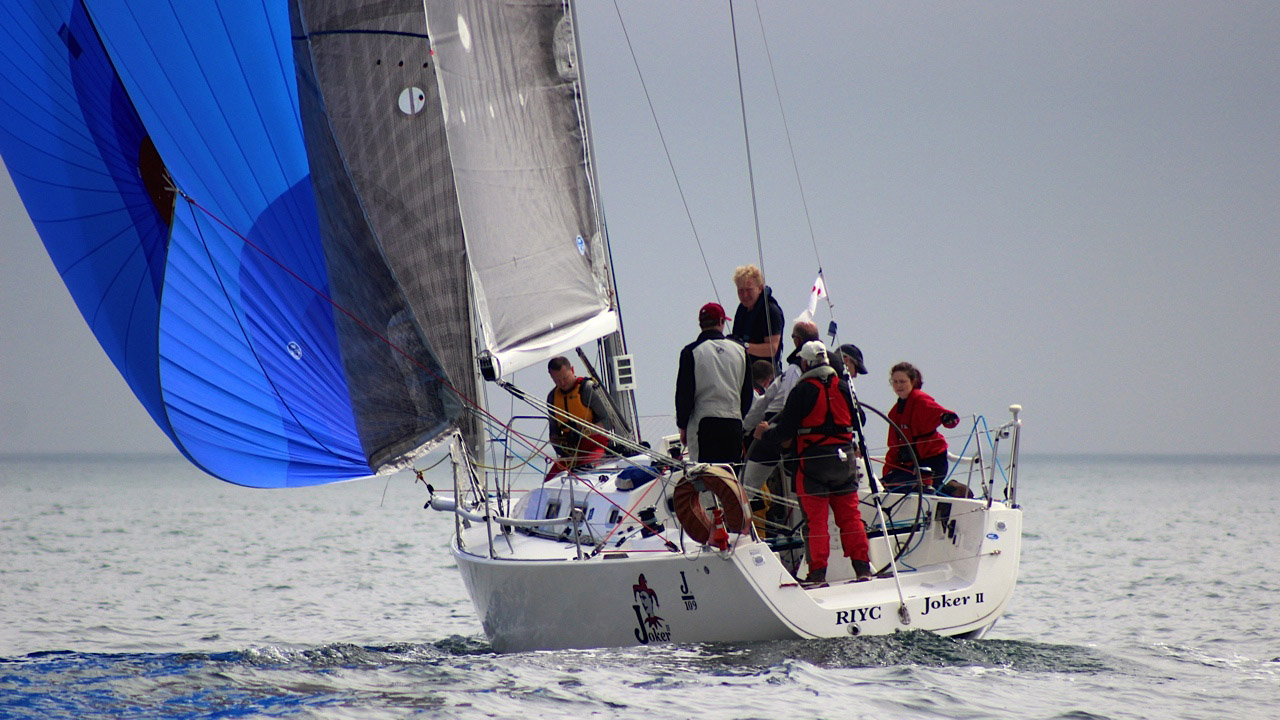
Dublin Bay's Joker II is second overall in IRC one
As previously mentioned, in Division One IRC, one of the hardest fought divisions the current two first places are occupied by RCYC Ian Nagle's J109 Jelly Baby, currently riding high on a succession of major wins, followed John Maybury's Joker 2 another J109 and a previous winner of this class Rob McConnell's Archambult 35 Fool's Gold in third place. Following in fourth place is Richad Fides Corby 33, with Paul O'Higgins Rocakbill V in fifth and Pat Kelly's J109 Storm in sixth place. A truly formidable line up and a good week of battle to look forward to.

The Quarter Tonner Cartoon (Ken Lawless, Joe Brady, Sybil McCormack) second in class four
As reported today in Afloat.ie, the battle for the half tonners is in already in full swing. With the first four positions dominated by Howth Yacht Club led by David Cullen's Checkmate XV with two wins, with Harmony having to be content with two seconds. Lying third is the well travelled Equinox the X332 of Ross McDonald on equal points with another half tonner Michael and Richard Evans The Big Picture.
Tomorrow's winds are expected to be stronger so a great day's racing lies in store
Results ICRA Nationals & Sovereign's Cup 2015
Day 1, after 2 races sailed (24th June 2015)
Division 0 IRC
1 Keronimo, Andy Williams (Yealm Yacht Club)
2 Crazy Horse, Norbert Reilly/Alan Chambers (Howth Yacht Club)
3 Roxstar, Jonathan Anderson, (Clyde Cruising Club)
Division 0 ECHO
1 Roxstar, Jonathan Anderson, (CCC)
2 Crazy Horse, Norbert Reilly/Alan Chambers (HYC)
3 Forty Licks, Jay Colville, East Down YC
Division 1 IRC
1 Jelly Baby, Ian Nagle, (Royal Cork Yacht Club)
2 Joker 2, John Maybury, (Royal Irish Yacht Club
3 Fool's Gold, Robert McConnell (Wicklow Harbour SC)
Division 1 ECHO
1 Adrenalin, Joe McDonald (National Yacht Club)
2 Raptor, Denis Hewitt & others (RIYC)
3 Joie de Vie, Glenn Chaiul, Silvie Blazkova (Galway Bay SC)
Division 2 IRC
1 Checkmate XV, Davie Cullen, HYC
2 Harmony, Jonny Swan/James Freyne, HYC
3 Equinox, Ross McDonald, HYC
Division 2 ECHO
1 Harmony, Jonny Swan/James Freyne, HYC
2 Jostler, Patrick Beckett, (KYC)
3 Checkmate XV, Davie Cullen, HYC
Division 3 IRC
1 Fusion, Richard Cowell, (HYC)
2 Bad Company, Desmond, Ivers, Deasy (RCYC)
3 Alpaca, Paul & Deirdre Tingle (RCYC)
Division 3 ECHO
1 Reavra, Stephen Lysaght (KYC)
2 Maximus, Paddy Kyne (HYC)
3 White Mischief, Timothy Goodbody (RIYC)
Division 4 IRC
1 Blackfun, Tony Hayward (Cowes)
2 Cartoon, Ken Lawless, Joe Brady, Sybil McCormack (RIYC)
3 Anchor Challenge, Paul Gibbons, (RCYC)
Division 4 ECHO
1 White Magic, Donal Harding, Waterford Harbour Sailing Club
2 No-Gnomes, Leonard Donnery, (RCYC)
3 Seven Whistler, Rene Wubben (WHSC)
J109
1 Jelly Baby, Ian Nagle (RCYC)
2 Joker 2, John Maybury (RIYC)
3 Storm, Pat Kelly (Rush SC/HYC)
Quarter Tonner
1 Cartoon, Ken Lawless, Joe Brady, Sybil McCormack (RIYC)
2 Blackfun, Tony Hayward (Cowes)
3 Anchor Challenge, Paul Gibbons (RCYC)
White Sail Division 1 IRC
1 White Lotus, Paul Tully, (Dun Laoghaire Motor YC)
2 Bite the Bullet, Colm Bermingham, (HYC)
3 Val Kriss,Nigel Dann (KYC)
White Sail Divison 1 ECHO
1 White Lotus, Paul Tully, (Dun Laoghaire Motor YC)
2 Baccarat, Anthony/Brian McCarthy (KYC)
3 Sonas, David Ross (KYC)
White Sail Division 2 IRC
1 Demelza, Windsor Laudan, (HYC)
2 Loch Greine, Tom O'Mahony (RCYC)
3 Saoirse, Richard Hanley (KYC)
White Sail Division 2 ECHO
1 Loch Greine, Tom O'Mahony (RCYC)
2 Demelza, Windsor Laudan, (HYC)
3 Guinness Kann, Caroline Forde (KYC)_
Full results here
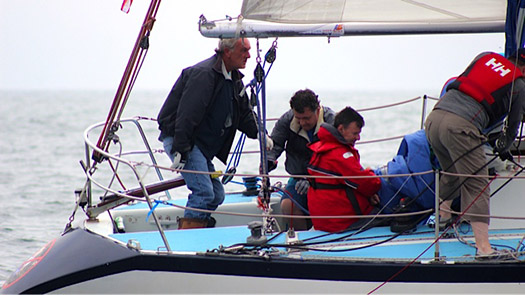
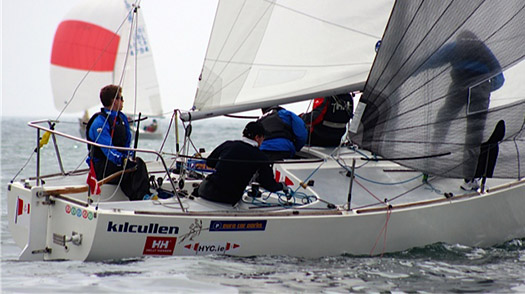


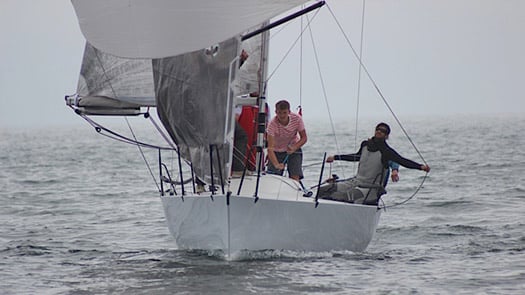
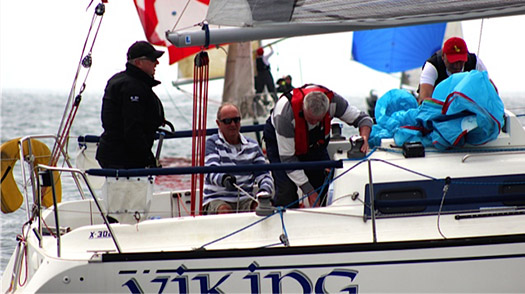

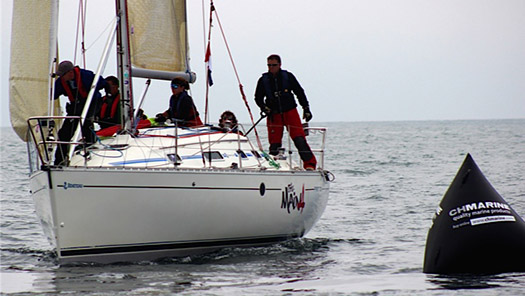
Royal Cork's Jelly Baby is UK J109 Champion
#j109 – In the UK J/109 National Championship, 17 J/109s had an intense battle with Ian Nagle's Royal Cork YC team, racing Jelly Baby, taking the crown as UK and Ireland National champion.
It is the second UK victory for the Royal Cork Yacht Club within a month, the first win being the Vice–Admiral's Cup in Cowes.
Nagle's Jelly Baby was looking good from the off and moved into an early lead on day one.
Tony Dickin's Hamble based J/109, Jubilee scored a first and a second today and a dramatic tie with Joe Henry's Jolly Jack Tar to claim second for the championship. Alan Bennett's Dorset team racing J/109 Blue Jay of Poole was third for the regatta.
"To go up on the stage with all the team and win the championship was fantastic, a great moment." commented Jelly Baby's Ian Nagle. I couldn't hope for a better crew and we are delighted we came over and I hope tht we will get a lot of boats over for Cork Week next year. We came here because we had done most of the events in Ireland and we wanted a different challenge."
#j109 – It's all smiles after the first day of the UK J/109 National Championship, with Ian Nagle's team from the Royal Cork Yacht Club scoring two bullets on J/109 Jelly Baby. "We had a great start in the first race, which put us in a good shape but we had a shocking start in the second and had to fight back from a very poor position, Nagle said.
The Cork Harbour boat, returns to Irish waters for the ICRA Nationals in Kinsale later this month, and has already tasted UK success this season lifting the vice–Admiral's Cup in Cowes in May.
The core of the Jelly Baby team has been together since they started racing the J/109 in 2008 and that experience means that they have built up a lot of knowledge about how to sail fast. 'I have to admit our boat speed was very good today. This has been a very encouraging start and we hope to build on that tomorrow', Nagle said.
Jelly Baby Scores J109 Nationals Title By One Point
#J109 - Ian Nagle's Jelly Baby pipped John Maybury's Joker by just one point to claim the J109 Nationals title at Dun Laoghaire's National Yacht Club at the weekend.
Twelve boats out of 16 took to the water for the seven races that got under way last Friday 18 July in trying weather conditions as sea fog swept over Dublin Bay.
The event was held in conjunction with the Ruffian 23 Nationals, won by Diane II of the Royal St George - with both pulled from the brink by the guiding hand of race officer Jack Roy, who got in three races despite the poor visibility.
Royal Cork's Yacht of the Year for 2012 topped the podium after an excellent Sunday's sailing, with Joker in second and third going to Stephen Tierney's Jedi.
In fourth was David Kelly on Storm, while fifth was Brendan Farrell with Jigamaree, sixth went to John Hall's Something Else, Jay Bourke placed seventh with Dear Prudence, and eight place was taken by Johnny Phillips' Jalapeño.
Rounding out the fleet were Declan Hayes on Indecision, Conor Totterdell on Mojito, and the newest J109s, Roger Smith's Wakey Wakey and Chris Moore's Powder Monkey.


























